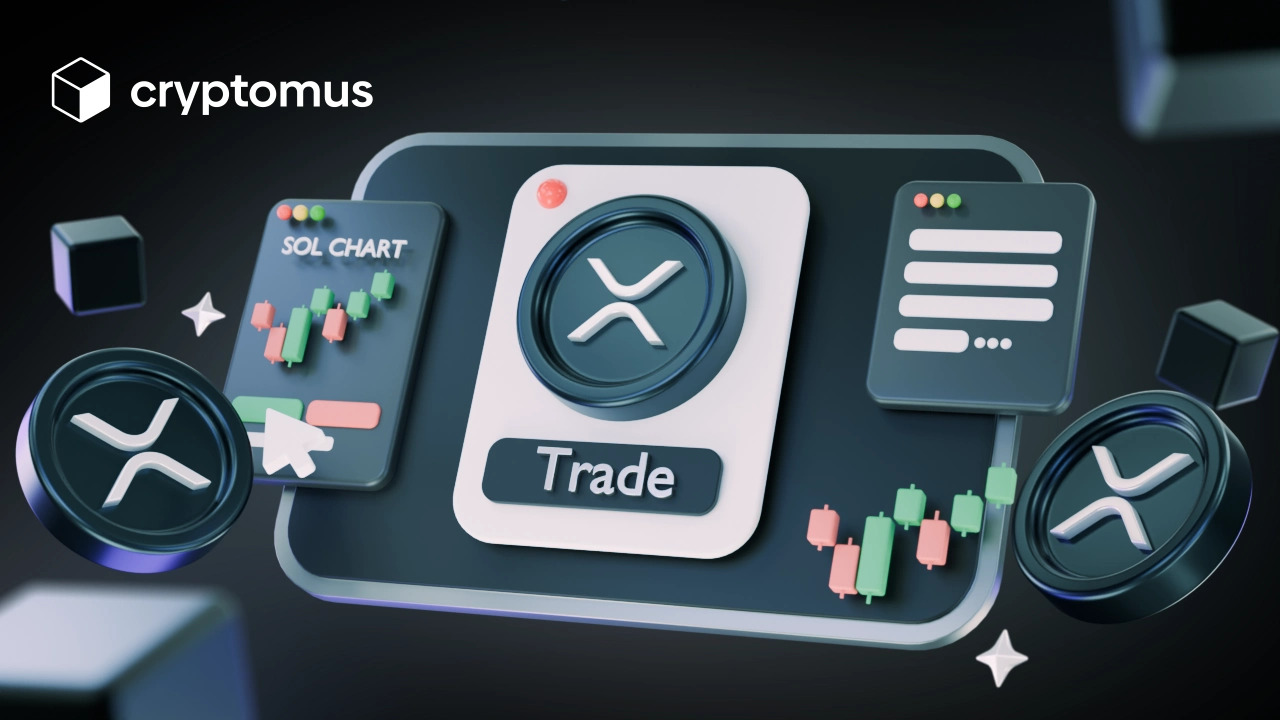
Giao Dịch Ripple Cho Người Mới Bắt Đầu: Cơ Bản, Các Loại Hình Và Chiến Lược
Cryptocurrency Ripple (XRP) được phát hành vào năm 2012, không lâu sau khi Bitcoin xuất hiện. Tuy nhiên, khác với BTC, các giao dịch XRP có đặc trưng là nhanh và khả năng mở rộng cao hơn. Trader tận dụng các lợi thế này bằng cách kiếm lợi từ biến động giá hoặc nắm giữ dài hạn. Hướng dẫn này sẽ cung cấp chi tiết về giao dịch Ripple, bao gồm các chiến lược và loại hình chính. Bạn cũng sẽ học “thuật toán” để bắt đầu và thành công khi giao dịch XRP.
XRP Trading Là Gì Và Hoạt Động Thế Nào?
Giao dịch Ripple là mua và bán coin tại những thời điểm khác nhau. Biến động giá có thể mang lại lợi nhuận, vì vậy quá trình này đòi hỏi theo dõi chủ động. Cách thức hoạt động là bán coin khi giá thị trường cao và mua khi giá thấp hơn.
Thông thường, giao dịch Ripple diễn ra trên các crypto exchange và mở cửa 7 ngày/tuần, kể cả cuối tuần. Nhiều loại lệnh như market và limit được trader sử dụng để vào lệnh. Limit order yêu cầu mua/bán ở mức giá cố định; trong khi market order cho phép mua/bán theo giá thị trường hiện tại. Trader phân tích trạng thái thị trường của Ripple để xác định thời điểm tốt nhất để vào lệnh.
Chiến Lược Giao Dịch Ripple
Các chiến lược giao dịch XRP là những cách tiếp cận mà trader dùng để mua và bán coin. Chúng khác nhau về mức rủi ro và có thể áp dụng trong nhiều điều kiện thị trường. Bao gồm day trading, swing trading, dollar-cost averaging (DCA), HODLing, và breakout trading. Dưới đây là chi tiết từng chiến lược.
Day Trading
Mua và bán Ripple trong cùng một ngày là đặc trưng chính của day trading. Chiến lược này tận dụng biến động giá nhanh và giảm rủi ro từ những biến động đột ngột qua đêm. Day trading đòi hỏi theo dõi thị trường kỹ lưỡng; nhà đầu tư thường dự báo bằng biểu đồ và chỉ báo (như RSI).
Swing Trading
Nắm giữ Ripple trong vài ngày đến vài tuần được gọi là swing trading. Ở đây, các biến động giá trung hạn (swings) mang lại lợi nhuận vì chúng lớn hơn biến động trong ngày. Cách tiếp cận này phù hợp với nhà đầu tư muốn hưởng lợi từ biến động giá XRP nhưng không có nhiều thời gian để theo dõi liên tục.
HODLing
Chiến lược lưu trữ XRP dài hạn gọi là HODLing. Đây không phải giao dịch chủ động; trọng tâm là lợi ích dài hạn thay vì biến động ngày/tuần. Cách làm này giả định người theo đuổi có kỳ vọng cao vào việc giá trị Ripple tăng khi mạng lưới mở rộng.
Dollar-Cost Averaging (DCA)
Chiến lược DCA là đầu tư một số tiền cố định vào Ripple theo định kỳ, bất kể giá thị trường. Ví dụ, bạn có thể đầu tư 5 USD vào XRP mỗi tháng. Cách này giúp bạn giảm volatility và bình quân giá vốn. Giá thấp thì mua được nhiều coin hơn, giá cao thì mua ít hơn. DCA phù hợp cho ai muốn tích lũy XRP mà không phải quá lo biến động thị trường.
Breakout Trading
Khi giá Ripple vượt cả mức resistance (đỉnh) lẫn support (đáy), đó là thời điểm áp dụng breakout trading. Tình huống này xảy ra khi giá coin phá vỡ vùng đi ngang trước đó. Ví dụ, XRP có thể dao động giữa 1 USD và 3 USD trong vài tuần. Trong giai đoạn này, trader mua/bán Ripple để kiếm lợi từ các nhịp biến động mạnh.

Các Loại Hình Giao Dịch Ripple
Khác với chiến lược, loại hình giao dịch tập trung vào cách thức mua/bán XRP. Ví dụ, một số trader giữ XRP làm đầu tư dài hạn, trong khi số khác muốn lợi nhuận nhanh. Hãy tìm hiểu sâu hơn.
Spot Trading
Spot trading là phương thức mua/bán Ripple theo giá hiện tại với kỳ vọng lợi nhuận ngay. Còn gọi là giao dịch ngắn hạn. Bạn mua XRP trực tiếp và ngay khi giao dịch hoàn tất, bạn nhận crypto về ví. Sau đó có thể giữ, bán, hoặc rút. Spot trading phổ biến trên các sàn như Coinbase và Binance.
Margin/Leverage Trading
Margin trading cung cấp leverage (đòn bẩy), tức bạn vay tiền từ sàn để giao dịch Ripple. Nhờ vậy, bạn có thể kiểm soát lượng XRP lớn hơn với vốn ban đầu nhỏ.
Ví dụ, nếu coin có giá 3 USD và bạn chỉ có 1 USD, bạn có thể mua 5 USD giá trị Ripple với đòn bẩy 5x. Chỉ cần giá tăng 4% là lợi nhuận trên vốn ban đầu đạt 20% nhờ đòn bẩy 5x; ngược lại nếu giá giảm, bạn có thể bị liquidate và mất tiền. Vì rủi ro này, margin thường chỉ phù hợp với trader giàu kinh nghiệm biết phân tích rủi ro. Các sàn như Binance và Bybit cung cấp hình thức này.
Futures Trading
Futures trading là khi nhà đầu tư ký hợp đồng cam kết mua/bán Ripple tại mức giá xác định vào một ngày tương lai. Giao dịch có lãi nếu đến ngày đó giá thị trường cao hơn mức đã thỏa thuận; ngược lại sẽ lỗ nếu giá giảm. Vì vậy, trader futures thường theo dõi sát market trends. Họ dùng các sàn như Bybit, Binance, và FTX.
Options Trading
Giao dịch options với Ripple tương tự futures, cũng liên quan đến ngày đáo hạn trong tương lai. Tuy nhiên, options cho phép trader thực hiện giao dịch ngay cả trước ngày đã chọn. Khi kỳ vọng giá tăng/giảm, trader dùng option để linh hoạt hơn. Các sàn hỗ trợ options gồm MEXC và OKX.
Short Selling
Khi giá Ripple giảm, short selling có thể mang lại lợi nhuận. Trader vay XRP từ broker (crypto exchange), bán ra theo giá thị trường, sau đó mua lại với giá thấp hơn để trả và hưởng chênh lệch. Rủi ro là nếu giá tăng mạnh, khoản lỗ sẽ phát sinh. Bạn có thể short trên các sàn như Binance hoặc Bybit.
Arbitrage
Trong giao dịch Ripple, arbitrage là kiếm lợi từ chênh lệch giá giữa nhiều sàn. Trader mua rẻ ở một nơi và bán cao ở nơi khác. Rủi ro thấp, nhưng cần hành động nhanh vì chênh lệch biến mất nhanh chóng. Nếu muốn thử, bạn nên chọn sàn có giao diện thân thiện như Cryptomus hoặc Kraken.
Automated Trading (Bots)
Automated trading bots cho Ripple sử dụng phần mềm thực thi giao dịch tự động theo chiến lược và điều kiện thị trường định sẵn. Bot ra quyết định nhanh và chính xác hơn thao tác thủ công vì luôn theo dõi dữ liệu. Để dùng bot hiệu quả, bạn cần hiểu công nghệ và chọn chiến lược phù hợp. Dịch vụ cung cấp bot bao gồm Cryptohopper và Pionex.
Cách Bắt Đầu Giao Dịch Ripple?
Giờ hãy xem kỹ cách giao dịch Ripple trên crypto exchange. Quy trình nhìn chung giống nhau trên mọi nền tảng. Dưới đây là “thuật toán” chi tiết:
-
Bước 1: Chọn chiến lược và loại hình giao dịch. Từ các cách tiếp cận đã liệt kê, hãy chọn phương án phù hợp nhất với nhu cầu của bạn khi giao dịch Ripple.
-
Bước 2: Chọn crypto exchange. Chọn nền tảng giao dịch Ripple bạn muốn dùng. Hãy cân nhắc khả năng hỗ trợ loại hình/chiến lược đã chọn. Nền tảng cũng cần bảo mật mạnh và có danh mục hoạt động rộng. Ví dụ, trader có thể giao dịch tự tin trên Cryptomus P2P exchange vì nền tảng cung cấp 2FA và AML để bảo vệ tài sản và dữ liệu. Để chắc chắn, hãy xem chính sách bảo mật và đọc đánh giá người dùng.
-
Bước 3: Tạo tài khoản. Đăng ký trên nền tảng đã chọn bằng tên và email. Sau đó hoàn tất KYC: chuẩn bị hộ chiếu hoặc bằng lái và sẵn sàng chụp selfie để xác minh danh tính.
-
Bước 4: Nạp tiền. Nạp fiat hoặc cryptocurrency vào exchange wallet. Bạn có thể liên kết thẻ ghi nợ/tín dụng với một số sàn để giao dịch.
-
Bước 5: Chọn cặp giao dịch. Đảm bảo số tiền bạn nạp khớp với lượng Ripple muốn mua. Nếu nạp đô la, cặp sẽ là “USD/XRP”; nếu nạp Litecoin, cặp sẽ là “LTC/XRP”.
-
Bước 6: Thực hiện giao dịch. Tiến hành theo chiến lược đã chọn: vào trang phù hợp, điền thông tin (ví dụ market hoặc limit order) và xác nhận. Giờ bạn có thể theo dõi và quản lý vị thế.
Mẹo Giao Dịch XRP Để Tối Ưu Lợi Nhuận
Bạn nên giao dịch Ripple thận trọng để giảm lỗ và tăng lợi nhuận. Dưới đây là một số khuyến nghị:
-
Chọn crypto exchange uy tín. Giao dịch crypto thường liên quan số tiền lớn; vì vậy hãy dùng nền tảng đảm bảo XRP của bạn an toàn. Commissions và mức giá coin trên sàn cũng ảnh hưởng lợi nhuận cuối cùng, nên hãy cân nhắc kỹ các con số này. Tham khảo thêm về commissions.
-
Theo dõi thị trường. Đọc tin tức về Ripple và thị trường nói chung để luôn cập nhật các diễn biến trong lĩnh vực crypto. Xem xét xu hướng thị trường khi xác định hướng giá coin.
-
Áp dụng phân tích kỹ thuật. Học cách đọc biểu đồ giá Ripple và các chỉ báo kỹ thuật. Điều này giúp bạn nhận diện xu hướng.
-
Quản trị rủi ro. Chỉ sử dụng số tiền có thể chấp nhận rủi ro, vì giá có thể giảm mạnh. Hạn chế dùng tiền vay để bảo vệ tài sản trước biến động.
Hãy tuân thủ các nguyên tắc này nếu bạn muốn giao dịch Ripple an toàn và hiệu quả. Hãy nhớ thị trường crypto biến động rất mạnh, nhất là khi đang phát triển. Các loại hình và chiến lược giao dịch Ripple sẽ chỉ thực sự phát huy khi bạn vận dụng kỷ luật.
Đánh giá bài viết




bình luận
0
Bạn phải đăng nhập để đăng bình luận